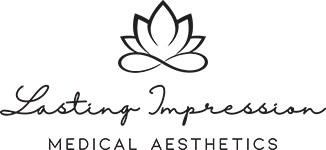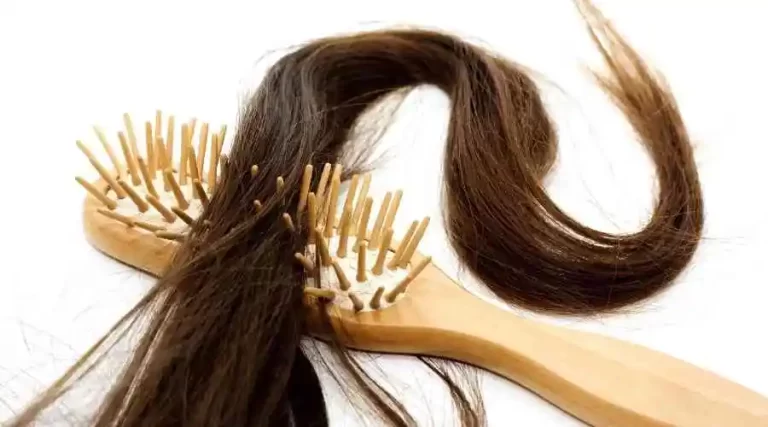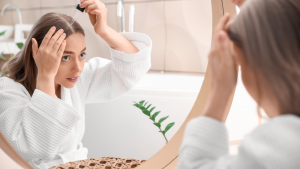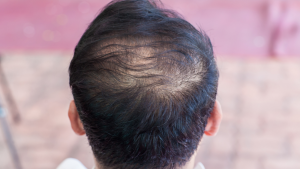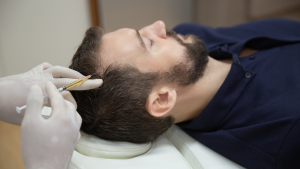It was a game-changer when the FDA first approved minoxidil for treating male androgenetic alopecia (AGA). We were witnesses to history. It was previously thought that there was no treatment for hair loss. This discovery naturally sparked a flurry of study into new treatments.
- Medical devices
- Oral
- Pharmaceutical
- Plant-based
- Regenerative medicine (PRP)
- Topical
Sifting through all the data and determining the most effective methods might be daunting. However, it is exactly what this post intends to accomplish.
How Are Hair Loss Treatments Evaluated?
The success of a hair loss treatment can be measured in two ways. So-called subjective judgment, often known as global photography, is the original type of photojournalism. The patient’s entire head is photographed before and after the procedure.
Here’s an example of a before-and-after photo from a research project.
One or more blinded dermatologists then evaluate each set of photographs. In this case, the dermatologists are considered impartial because they did not treat the patients. Because they don’t know which treatment each individual received, they’re also completely blind. Active therapy vs. placebo or active treatment one vs. active treatment 2, etc., could have been the comparisons here.
Subjective evaluations frequently use the following scale:
- 0 for no visible regrowth
- 1 for minimal or barely visible regrowth
- 2 for moderate or easily visible regrowth
- 3 for significant regrowth that is both easily visible and extensive
Objective hair counts or macro photography are the other two options. Researchers have discovered a small area of the scalp that is balding. This 1 cm2 spot is usually found on the top of the head. Researchers use a semi-permanent tattoo to identify the patch’s location when they’ve found it.
Close-up images of this area are taken before and after treatment with specialized cameras. To get an accurate count, they either count each hair one at a time or use specialized imaging software.
The number of new hairs developing in the sample can be determined this way.
Benefit of Both Approaches
Both subjective and objective ways of evaluation are helpful. We can use subjective assessments to know if we’re making progress. After all, the patient wants to change how he and others see his hair. Zoomed-in hair counts, on the other hand, are inferior in this regard.
When comparing different therapies, however, objective hair counts are preferable. As far as hair loss research is concerned, these studies are considered the “gold standard.” Hair counts are used in every meaningful research, even those supported by large pharmaceutical corporations. The number of new hairs per square centimeter (cm2) summarizes the treatment’s success. In this manner, we can directly compare various treatment modalities.
Benefit of Both Approaches
Both subjective and objective ways of evaluation are helpful. We can use subjective assessments to know if we’re making progress. After all, the patient wants to change how he and others see his hair. Zoomed-in hair counts, on the other hand, are inferior in this regard.
When comparing different therapies, however, objective hair counts are preferable. As far as hair loss research is concerned, these studies are considered the “gold standard.” Hair counts are used in every meaningful research, even those supported by large pharmaceutical corporations. The number of new hairs per square centimeter (cm2) summarizes the treatment’s success. In this manner, we can directly compare various treatment modalities.
Best & Worst Treatments
Now that we’ve gone through all the available information, we’re ready to organize it into a single table. The treatment table has 14 options. Selected values for seven of these were taken from Gupta et al. The last seven were tacked on later.
Bimatoprost
Bimatoprost is one of the lesser therapies, and the FDA has not approved it for male AGA. Also prohibitively pricey, it is not worth the effort. AGA men are unlikely to be interested in this.
Minoxidil 2& or 5%
The following therapy on the list, minoxidil 2 percent, is likewise popular. Sadly, it’s not up to par with the rest of the treatments on the market. User preference should favor the 5 percent solution, which provides significantly superior regrowth.
Ketoconazole
In terms of efficacy, ketoconazole shampoo is somewhere between 2% and 5% minoxidil. As a shampoo, it has a significant advantage. As a result, it has a high level of usability.
Clascoterone
Topical antiandrogen Clascoterone has the potential to revolutionize the treatment of male impotence. The FDA only recently licensed it for use against acne-prone skin. This medicine may be the next one to be approved for treating male AGA. Clascoterone’s hair count data is quite scarce. Press releases from the manufacturer are the primary source of information. The reported value of 14.3 new hairs/cm2 is comparable to that of a 5-percent minoxidil solution. It was also noted to show antiandrogen. This lends credence to the reported value.
Oral Finasteride
Regardless of concentration, oral finasteride outperforms minoxidil monotherapy as expected. Studies that directly compared the two therapies agree with this conclusion.
Dutasteride
Dutasteride is the other systemic DHT blocker. Compared to finasteride, this is more potent and also slightly more effective. Dutasteride is superior in studies that directly compared the two therapies.
Redensyl
Redensyl falls in between finasteride and dutasteride. Natural hair growth is the goal of this product. Redensyl’s higher efficacy over oral finasteride is hard to comprehend. The evidence is flimsy and hasn’t been vetted by anyone else. Even though Redensyl has been on the market for a long time, men with AGA still have few options.
PRP
When all else fails, there’s PRP. This is the second most effective treatment in terms of hair loss. It has twice as many hairs as finasteride. If this is the case, most people should see some regrowth. However, most customers are dissatisfied with the results. PRP is viewed with skepticism by the hair loss community because of its exorbitant cost. The medical profession is similarly divided about whether or not PRP is a natural treatment for hair loss. Because of these considerations, it is challenging to trust the PRP hair count value at face value.
Microneedling With Minoxidil
Microneedling in conjunction with minoxidil is the most effective treatment available. Compared to finasteride or 5 percent minoxidil, 50 new hairs/cm2 is three times as effective. Also, it’s around 2.5 times more effective than minoxidil plus finasteride, the following most plausible medication. These numbers, despite their astronomical price, are reasonable.
According to several studies, they are distinct. There is a good correlation between the dermatologists’ subjective assessments and the hair counts (visible improvement for nearly all patients). There is also photographic proof. Moreover, there is no severe conflict of interest for researchers. Minoxidil is no longer patent-protected, and microneedling equipment costs practically nothing. Even though LLLT and PRP have intense conflicts of interest, this does not apply here.
Among men with AGA, microneedling has also been a standard treatment option. The internet is awash with user images that appear to show almost complete restoration of the hair follicles. A combination of these factors suggests that this treatment’s implausible success is much more likely than previously thought.
Our Recommendations
In Terms of Efficacy
When it comes to efficacy, there is already a sure winner. The combination of microneedling and topical minoxidil is the most effective. It is several times more effective than typical monotherapies such as finasteride or minoxidil. It’s safe to say that almost all of our users have noticed some regrowth. Around a third of people will see a significant difference due to this change. In addition, it is a low-cost procedure. Using minoxidil topically can result in moderate skin responses or side effects.
Alternative Methods
The 2 percent concentration of minoxidil appears too weak to be of much use as a monotherapy. The 5 percent formulation is the best option. Finasteride-enhanced minoxidil provides even better results while avoiding the negative effects of standard finasteride administration.
Additionally, redensyl monotherapy should be avoided. It may, however, be useful in combination with other treatments. LLLT and PRP, two newer, more expensive treatments, pose an issue.
LLLT requires a significant investment in the right equipment for home use. It’s also the most time-consuming of all of the options. At least three times a week, a minimum of 15 minutes is allotted for each treatment. Less time-consuming and more effective therapies are available, making this expenditure complicated to defend.
In terms of cost, PRP is among the priciest therapies available. PRP makes sense as a treatment option for guys who don’t have a tight budget. Once or twice a year are the intervals between sessions. As a result, little effort is required on your part. Almost no adverse effects can be expected. The worse possible result would be the lack of improvement in the condition. It may be effective as a monotherapy for a small percentage of males.
Having said that, money is a concern for most men with AGA. PRP does not make sense in this situation. Botox is subject to the same considerations.
Possible Drawbacks for This Approach
Best Possible Solution
There are severe constraints to this paper exercise. When comparing all hair loss treatments, these issues come to light. A single study would be required. It would be conducted by a single research team and adhere to the same protocol. This is how it would appear:
Thousands of volunteers may be enlisted by a vast, multidisciplinary group of scientists with infinite resources. Volunteers would all meet the same criteria for inclusion and exclusion. Using a single set of criteria, their baseline hair count would be reported.
One of the treatments would be chosen at random for each volunteer. Their hair counts would be re-examined after six to twelve months. In addition, blind dermatologists would also subjectively evaluate the before and after images of the entire head.
Attempting to do such a research project is nearly difficult. It would be impractical and costly to implement. Only a few organizations and global corporations have the resources and logistics to carry out such an undertaking. However, no one is driven to do so by a desire for financial gain.
Suggested Compromise
An alternative is a compilation of several studies, which is what this article attempts. It’s an issue, of course, because the essential criteria vary from one study to the other. The participants, the technicians, the methodology, the treatment period, and so on are all included in this category.
Additionally, we had to make choices about which research to include, such as whether or not to include studies involving women or whether or not to incorporate data from sources that were not peer-reviewed.
In most cases, medications that are effective for women will also be effective for male patients. However, the overlap isn’t perfect, and female hair loss is typically easier to manage. Because of this, we decided to remove any research, including women. The studies from non-peer-reviewed sources, on the other hand, like press announcements from companies, were included. Alternatively, some treatments could have been omitted entirely.
Compiling all of this data into a single table necessitates a lot of statistical considerations. Adjusting values that look excessive, for example, accounting for sample size in research, etc. We explained the reasoning behind these judgments. We erred on brevity and wrote with a non-academic audience in mind. Some other authors may have made different decisions. In most cases, these are justifiable.
Because of all of the above, the current analysis is abysmal. Readers should think of it as a general guide. This analysis can be omitted if you choose not to make any quantitative comparisons.For more information, call us for a Consult at Bergen County Hair Loss by Lasting Impressions or visit us at https://bergencountyhairloss.com/.
